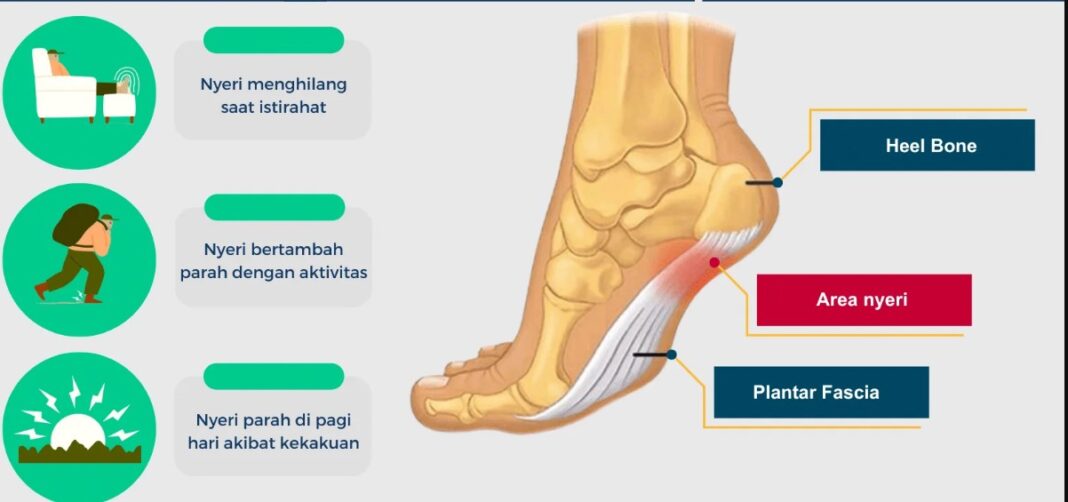BOURSESSENEGAL – Plantar fasciitis is a common condition that affects many people, causing pain in the heel and bottom of the foot. If you’ve ever felt a stabbing pain in your foot, especially in the morning, you might be dealing with plantar fasciitis. In this comprehensive guide, we’ll explore what causes this condition, the symptoms to watch for, and effective treatment options to relieve the pain and get you back on your feet.
What Is Plantar Fasciitis?
Plantar fasciitis occurs when the plantar fascia, a thick band of tissue connecting your heel bone to your toes, becomes inflamed. This condition often arises from overuse or stress, particularly in individuals who are active in sports, have flat feet, or are overweight. Understanding the basics of plantar fasciitis is crucial for anyone experiencing foot pain.
The Anatomy of the Foot
To comprehend plantar fasciitis, it helps to understand the anatomy of the foot. The plantar fascia supports the arch of your foot and absorbs shock. When too much pressure is placed on it, micro-tears can occur, leading to inflammation and pain.
Causes of Plantar Fasciitis
Identifying the underlying causes of plantar fasciitis can help you prevent future flare-ups. Here are some common factors that contribute to this condition:
1. Overuse and Activity Level
High-impact activities, like running or jumping, can put excessive strain on the plantar fascia. If you suddenly increase your activity level, you might find yourself dealing with this painful condition.
2. Foot Structure
Flat feet or high arches can affect how weight is distributed across your feet. These structural issues can lead to an increased risk of developing plantar fasciitis.
3. Age
As we age, the elasticity of the plantar fascia decreases. This makes older adults more susceptible to injuries.
4. Occupation
Jobs that require long periods of standing or walking can increase the risk of plantar fasciitis. Teachers, factory workers, and nurses often experience foot pain due to their demanding roles.
Symptoms of Plantar Fasciitis
Recognizing the symptoms of plantar fasciitis is essential for early intervention. Common signs include:
1. Heel Pain
The most prominent symptom is a sharp pain in the heel, especially noticeable in the morning or after prolonged periods of sitting.
2. Stiffness
Many individuals report stiffness in the foot upon waking or after sitting for a while. This stiffness often eases with movement.
3. Swelling
Some people may experience mild swelling in the heel area, which can accompany the pain.
Diagnosing Plantar Fasciitis
If you suspect you have plantar fasciitis, seeking medical advice is crucial. A healthcare professional can perform a physical examination and may request imaging tests like X-rays to rule out other conditions, such as fractures.
Effective Treatments for Plantar Fasciitis
Fortunately, several treatment options can help alleviate the pain associated with plantar fasciitis. Here are some effective strategies:
1. Rest and Ice
Resting your feet and applying ice can reduce inflammation. Ice your heel for 15-20 minutes several times a day, especially after activities.
2. Stretching Exercises
Incorporating stretching exercises into your routine can improve flexibility and relieve tension in the plantar fascia. Here are a few effective stretches:
Toe Stretch
Sit down, cross one foot over the other, and gently pull back on your toes. Hold this position for 15-30 seconds.
Calf Stretch
Stand facing a wall, place your hands against it, and step one foot back, keeping it straight. Lean into the wall until you feel a stretch in your calf.
3. Footwear Matters
Choosing the right shoes is vital for preventing and treating plantar fasciitis. Look for supportive footwear with good arch support and cushioning. Avoid wearing high heels or flip-flops, as they lack support.
4. Orthotics
Custom or over-the-counter orthotic inserts can provide additional arch support and relieve pressure on the plantar fascia. Consider consulting a podiatrist for personalized recommendations.
5. Physical Therapy
A physical therapist can guide you through specific exercises tailored to strengthen the muscles in your feet and improve your gait.
6. Medications
Non-steroidal anti-inflammatory drugs (NSAIDs), like ibuprofen or naproxen, can help reduce pain and inflammation. However, consult your doctor before taking any medication.
7. Night Splints
Wearing a night splint can keep your foot in a flexed position overnight, which helps stretch the plantar fascia and Achilles tendon.
8. Shockwave Therapy
In some cases, healthcare providers may recommend shockwave therapy to stimulate healing in the plantar fascia.
9. Surgery
Surgery is a last resort for severe cases that don’t respond to conservative treatments. Procedures may involve releasing the plantar fascia or removing bone spurs.
Prevention Tips for Plantar Fasciitis
Preventing plantar fasciitis is often more effective than treating it. Here are some proactive strategies to keep your feet healthy:
1. Maintain a Healthy Weight
Excess weight can put additional stress on your feet. Maintaining a healthy weight can alleviate pressure on the plantar fascia.
2. Gradually Increase Activity Levels
If you’re starting a new exercise routine, gradually increase your intensity and duration to avoid overuse injuries.
3. Incorporate Foot Strengthening Exercises
Strengthening the muscles in your feet can help support the plantar fascia. Simple exercises, like picking up marbles with your toes, can make a difference.
4. Stay Hydrated
Drinking enough water is crucial for overall health, including joint health. Hydration helps maintain the elasticity of tissues.
Conclusion
In summary, plantar fasciitis is a common condition that can significantly impact your quality of life. By understanding its causes, recognizing symptoms, and implementing effective treatment strategies, you can find relief and improve your foot health. Remember, early intervention is key. If you experience persistent heel pain, don’t hesitate to consult a healthcare professional for guidance. Your feet deserve the best care, and taking proactive steps today can lead to a healthier, more active tomorrow.
REFERENCE : https://www.cdcfoundation.org/



